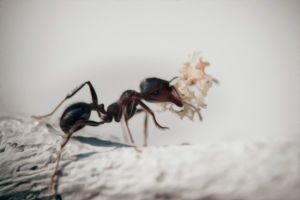Do It Yourself Fly Spray
Flies!! The harbinger of doom for what would be an enjoyable time, indoors or outdoors. They can make pleasant picnic under a tree become a hour-long stress and frustrations session. Sure, they have their purpose in the circle of life, but come on!! Just leave us alone for one afternoon would ya!
Time to win back your afternoon, whether you are hiking, horseback riding, or just hanging out on the porch. These DIY fly sprays typically use essential oils as the main deterrent.
.
In this article:

How DIY Fly Sprays Work
Plants have evolved to create odors when they get damaged in an effort to defend themselves from being eaten by insects. Some are more effective than others of course. When the vapors come in contact with antennae and the mouth-area of the insect, the insect detects it and is repelled away. This is the primary method of repelling flies with a DIY spray. While some research has been done on natural repellents, it hasn’t been particularly robust. A lot of the knowledge of repellency from natural oils comes from historical use from various cultures.
DIY Fly Spray Recipes
Below are a few easy recipes to create your spray. Please note that when using it on animals, such as horses, always test a small amount first, and let them smell it before using it.
Essential Oil Fly Spray
Almost all DIY fly sprays out there are a variation of this recipe. You can try the different oils to see which one works the best for your situation.
Recipe:
- 3 teaspoons of essential oil. Choose one or two of the following: Lavender, peppermint, citronella, cedarwood, patchouli, geranium, or lemon eucalyptus, lemongrass, cinnamon, or rosemary.
- 1 cup of distilled water
- ¼ cup of mixing oil. Almond or avocado oil are good for spraying on the skin (be mindful of allergies for some people).
- 1/3 cup of vodka or witch hazel ( you can also use rubbing alcohol). The witch hazel helps keep the fly spray on your skin longer.
- 1 Spray bottle
Directions:
- Place all ingredients in the bottle.
- Stir the solution well.
- Spray generously throughout the area you want to protect. Spray on skin or clothes. Remember, keep away from eyes and test on a small area when spraying animals.
Simple Vinegar and Eucalyptus Fly Spray
Recipe:
• 2 Cups white vinegar
• 1 Tablespoon of Eucalyptus essential oil
• 1 Cup of water
• 1 Spray bottle
Directions:
- Place all ingredients in the bottle.
- Stir the solution well.
- Spray generously throughout the area you want to protect. Remember, keep away from eyes and test on a small area when spraying animals.
Even Simpler Vinegar Fly Spray
If you are in a pinch and just need something quick, you can opt for this recipe.
Recipe:
• Apple Cider Vinegar, preferably unpasteurized organic apple cider vinegar.
• 1 Spray bottle.
• Optional: water to dilute if you or your animal doesn’t like the smell of straight vinegar.
Directions:
- Place all ingredients in the bottle. If you are diluting with water, don’t dilute more than 50/50 water-vinegar.
- Stir the solution well.
- Spray generously throughout the area you want to protect. Remember, keep away from eyes and test on a small area when spraying animals.
Commercial Fly Sprays
If you’re not in the mood to make your own, there is a decent selection of commercial fly sprays that use the same natural ingredients such as essential oils and botanicals. Many people use them indoors and outdoors, and a lot of people with horses use the horse spray. We’ve sorted through some of the highest rated fly sprays on the market here.
Level Up, by Building a DIY Fly Trap
Sometimes the best defense is a good offense. See our instructions for creating natural DIY fly traps here.
The Forgotten Fly Repellent Chronicles
While fly sprays can deter, these strategies will get rid of flies before they are even born. No, this is not a mystical hex on these six-legged pests. Its just plain old tidiness. These strategies will keep the flies away because it minimizes their breeding and feeding grounds.
Strategies:
- Keep compost piles far away from the house: Compost is all about decomposing organic material. It has great benefits for enriching soil for your garden and landscaped areas. Flies, unfortunately, also thrive in decomposing environments. They breed and lay eggs in these parts. Keep the compost far from the house to minimize flies in your living space.
- Clean up animal poop quickly: Did someone say decomposing organic material? We all know animal poop is the undisputed heavy weight champion of fly attractants. Cleaning up animal waste frequently greatly reduces the fly population.
- Clean up any decaying organic matter, such as dropped fruit from trees, dead leaves, and large clumps of grass clippings: When the fruit drops, its only a mater of time before the flies show up. Keep these areas tidy and find a way to manage your grass lawn clippings so they are not piled in one area.
- Install plants that deter flies and other insects, such as marigolds, mint, lavender, yarrow, pitch plants, and rosemary. Whether its in your garden, patio, or even sunny areas in your kitchen, these plants are known to deter flies. They can be planted in the ground or in a pot. Some of them, such as mint and rosemary, are also herbs than can be used as ingredients in your meals.
